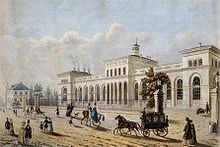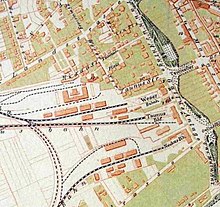Frankfurt Taunusbahnhof
The Taunus station was until 1888 the start and end point of the Taunus Railway , the Frankfurt with since 1839 Wiesbaden association. The starting and ending point of the route there was also called Taunusbahnhof . It was the first railway line in the territory of the Free City of Frankfurt , making the Taunusbahnhof the first station in Frankfurt am Main at all. Structurally nothing is left of it today.
Reception building
The station building of the terminus station was on the western edge of the ramparts and today's Willy-Brandt-Platz , then Gallustor , where today the Kaiserstraße meets the Gallusanlage. It was built from 1837 to 1839 based on a design by the Mainz architect Ignaz Opfermann .
The front building was a broad, one-story, two-wing complex with a three-story central pavilion on which a clock tower was attached, and two-story, slightly lower corner pavilions. For the building, sacrificemann chose forms from German classicism and the Italian-influenced neo-renaissance . The street-side facade was dominated by arches on the ground floor. Behind it lay the reception hall and the ticket office in the middle, the lounges, waiting rooms and baggage handling in the side wings. On the upper floor there were offices of the management of the railway company and apartments. The platform hall was a wooden structure and the first platform hall in Germany. A description of the building from the early days and the handling process that a traveler had to undergo can be found in the Allgemeine Bauzeitung . The construction cost almost 110,000 florins .
Immediately south of the Taunusbahnhof, the Main-Neckar-Bahnhof opened in 1848 , and the Main-Weser-Bahnhof opened to the north in 1850 . The hotel " Westendhall " was located between Taunusbahnhof and Main-Weser-Bahnhof .
The three adjacent railway stations formed an ensemble as Frankfurt West Railway Stations until 1888 and were then replaced by the new Centralbahnhof , which is now Frankfurt Hauptbahnhof , about a kilometer further to the west . The subsequently superfluous facilities at the western train stations were demolished. The station district was created on the resulting wasteland . The name of the Taunusanlage is derived from this train station.
Its counterpart, the Taunusbahnhof in Wiesbaden , existed until 1906, when it was also replaced by a new terminal station that unified the lines that ended there.
See also
literature
- Lichthammer: Over some train stations in western Germany and Belgium . In: Allgemeine Bauzeitung 7 (1842). Vienna, pp. 354-363 (359).
- Volker Rödel, Heinz Schomann : Monument topography Federal Republic of Germany . Cultural monuments in Hessen. Railway in Hessen . Ed .: State Office for Monument Preservation Hesse . 3 volumes. Theiss Verlag, Stuttgart 2005. ISBN 3-8062-1917-6 .
- Silvia Speckert: Ignaz Opfermann (1799–1866): Selected examples of his construction work in the vicinity of the city of Mainz = housework to obtain the academic degree of a Magister [!] Artium. Johannes Gutenberg University Mainz 1989. Typed. Volume 1: Text, Volume 2: Tables. Mainz City Archives: 1991/25 No. 11.
Web link
- The Taunusbahnhof. altfrankfurt.com
Individual evidence
- ↑ Speckert, p. 69; Rödel, Schomann: Railway in Hessen Vol. 2.1, p. 22.
- ↑ Speckert, p. 69.
- ↑ Grossart: The development of the railway buildings in the Rhine-Main area . In: Die Reichsbahn 16 (1940), pp. 200–215 (200).
- ↑ Lichthammer, p. 359.
- ↑ Lichthammer, p. 359.
- ↑ Grossart: The development of the railway buildings in the Rhine-Main area . In: Die Reichsbahn 16 (1940), pp. 200–215 (200).
- ↑ Grossart: The development of the railway buildings in the Rhine-Main area . In: Die Reichsbahn 16 (1940), pp. 200–215 (200f).
Coordinates: 50 ° 6 ′ 33 ″ N , 8 ° 40 ′ 18 ″ E





